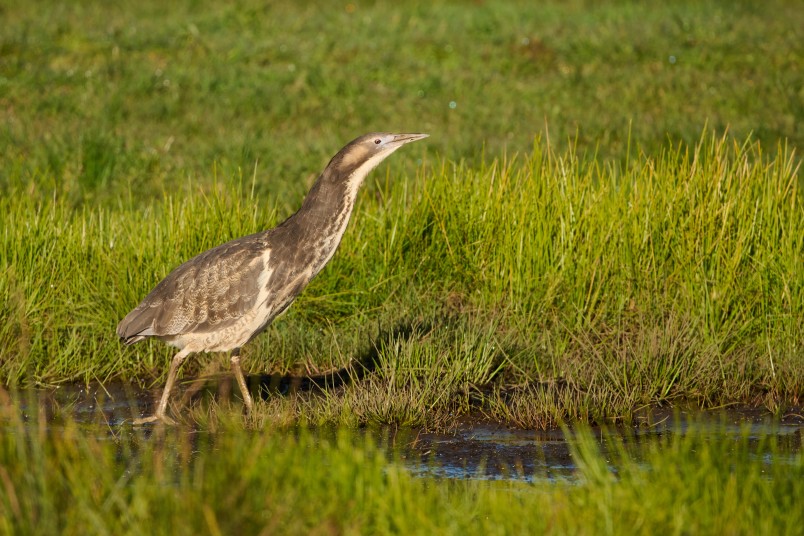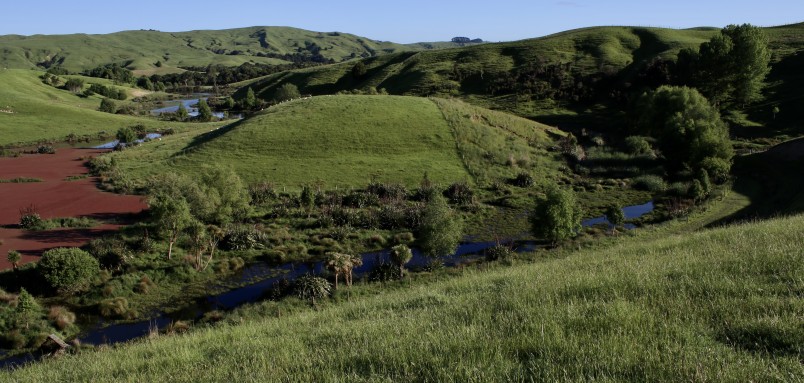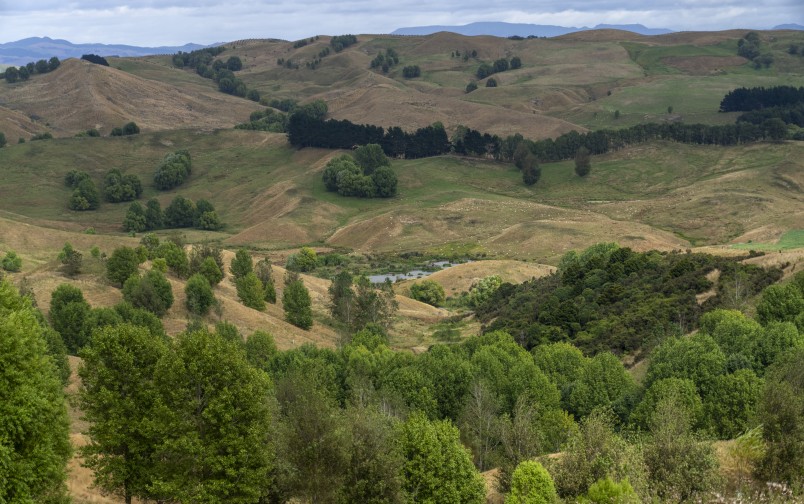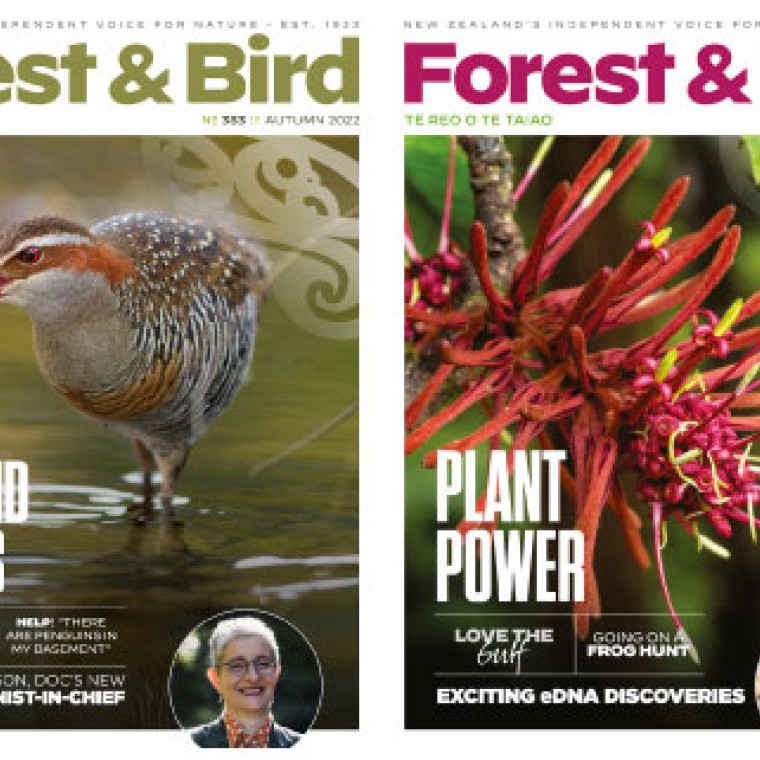Hawke’s Bay farmer James Hunter shares his conservation story in the hope it will inspire others to choose nature-based solutions on their farms. By Caroline Wood
James Hunter is on a mission. He wants to provide a permanent home for matuku hūrepo Australasian bittern on his central Hawke’s Bay farm. He is planning to create 15ha of new wetlands to add to an existing network of waterways and create a whole farm habitat for the critically endangered species.
Forest & Bird magazine
A version of this story was first published in the Winter 2025 issue of Forest & Bird magazine.
The farmer-conservationist, who served on the Board of the QEII National Trust for nine years, has been building new permanent wetlands and restoring native vegetation and biodiversity on Rangitoto Station for decades.
Today, 54ha of his sheep and cattle farm near Pōrangahau is protected in perpetuity under a QEII covenant, including a 12ha network of thriving wetlands that play a key role in the health of his property.
All the native vegetation on Rangitoto is fenced off, and James pays for pest control to protect it from browsing deer and predators, such as feral cats. He says he has quadrupled the amount of carbon the 660ha farm has been sequesting since 1990 – with 150ha as permanent forest in the government’s emissions trading scheme.
James plans to create new wetlands and protected bush areas to create a nearly 30ha refuge for the iconic booming bittern, which are occasionally spotted at Rangitoto. With fewer than 1000 bitterns left in Aotearoa and their wetland home disappearing, they need a helping hand to survive.
“Bittern are in trouble. The talk is you need roughly 20ha of wetlands for them to have permanent habitat, and that’s what I’m aiming to create,” says James.
“The plan is to flood more areas to create this extensive wetland system surrounded by native bush and give them a permanent home, so they don’t have to leave.
“Our vision is that we’re going to be growing sheep and cattle surrounded by biodiversity. We’re going to have a farm that looks after nature.”
James’s family has owned and operated Rangitoto Station for more than 170 years – with successive generations fostering a deep connection with the land since 1854.
Over time, James has retired 15% of the land for conservation purposes, with the rest supporting a farming business raising lamb and beef.
You can see the Pacific Ocean from Rangitoto, which is fitting as James’s lamb is shipped across the ocean to be sold in the United States. For American consumers, the way their lamb is farmed matters.
Atkins Ranch, which markets and distributes high-quality New Zealand lamb from a small number of farms in Aotearoa, shared James’s conservation story with its customers recently.
“His dedication to the environment runs deep, from creating thriving ecosystems to ensuring crystal-clear water leaves his property,” said Karen Atkins. “The result? 100% grass-fed lamb raised with care, purpose, and a whole lot of heart.”
Marketing aside, James believes it’s possible to run a successful farming business while also being good guardians of the whenua land. His passion is inspiring others to follow in his footsteps, focus on their farm’s ecology, and help local biodiversity.
“I want to be able to say we haven’t just made money farming, we have also given nature a chance, and it’s flourished as a result,” he explains.
“We have done something for the ecosystem and environment to help birds, fish, insects, fungi, plants. It’s surprising how much has changed [for the better] over the years.
“This biodiversity stuff, it matters. We need to address it as a community, not just as individuals.”
In February, James organised a farm forestry field day to showcase the restored wetlands and the biodiversity benefits of allowing areas of farm “scrub” to return to thriving bush and native forest, a process he expects to take 100 years.
Field day speakers included specialists in indigenous biodiversity, water quality, and tree-growing. Together, the speakers covered issues such as building resilience on farm, addressing soil and nutrient loss, habitat restoration, and carbon sequestration.

The farm is a welcome refuge for bittern. Image Craig McKenzie
The event was attended by local conservation legend and wetland expert John Cheyne, who talked about the special nature of matuku hūrepo.
Bittern are near the top of the food chain in a wetland, which means they play a crucial role in maintaining the overall balance of a freshwater ecosystem.
For them to survive, conservationists need to consider all the elements needed for a healthy wetland, such as water quality, plants, invertebrates, frogs, fish, and tuna eels.
As well as supporting biodiversity, wetlands offer a nature-based solution to help us adapt to climate change and reduce disaster risk.
They store large amounts of carbon, recharge ground water, have a local cooling effect, reduce fire risk, and buffer communities from flooding and coastal storm surges.
He believes that creating a new native habitat starts with one small action. For him, it was restoring a wetland on the property because he didn’t want farm run-off containing polluting nutrients and sediment reaching the nearby Pōrangahau River.
James was in his mid-20s and travelling around South America in 1988 when he received a call from his father asking him to return to Rangitoto and help him with the farm.
He had spent a year travelling and saw first-hand the rate of burning and deforestation in the Amazon and the devastating impact of gold mining on local rivers. A family friend in the UK gave him a book on how to remove sediment and nutrients from waterways, which he read on the way home to New Zealand. These experiences left their mark.
Once home, he and his father John fenced off remnant pockets of native habitat, protecting them from farm animal browsing. Then James set about creating his first wetland. Things snowballed from there, as he found giving nature a helping hand rewarding personally and professionally.
Today, the interlinked wetland areas, carefully carved out by James before being flooded, act as giant kidneys for the property. During a major weather event, stormwater is captured in the wetlands and farm nutrients are filtered and processed.

New wetlands and native plantings at Rangitoto Station in 2020. Image Marie Taylor/Plant Hawke’s Bay
Even after a huge rainstorm, the water run-off from James’s property is clear. He is proud that his farming operations are not polluting local waterways.
“When I started farming, I was one of the changing faces who wanted to do things differently,” he explains. “I can show that it is possible to have farming and environmental custodianship.
“If every farmer in the country created 5ha or 10ha of wetlands, we’re going to redress some of what has been lost over the past decades. We can be agents for change. Like osmosis, we affect the actions of those around us.
“I’m hopeful for the future. I see a new generation of farmers who care about biodiversity on the farm. I believe more and more of them will restore wetlands as well as native bush.
“There’s some really neat things happening out of sight on farms. Give it 10 years, and we will see a real reversion.”
One of the aspects he wants farmers to understand is the importance of biodiversity in a thriving natural system and encouraging the right elements, including critters of all kinds, into a newly created habitat.
Worms, for example, are a sign of soil health. In 1982, his parents took part in a trial involving releasing black-headed worms (Aporrectodea longa) that can burrow down into a metre of soil. Over time, the worms spread across the whole station.
AgResearch returned a decade ago and found a huge number of worms in the soil – 1400 worms per square metre (300 worms per square metre is pretty good). The worms take organic matter deep into the lower layers.
“Those worms are changing our soil structure. It means it is freer draining, got everything going for it,” says James.
He is a proponent of restorative farming, an approach to food production that aims to create healthy, resilient farm ecosystems by restoring natural ecological systems, improving environmental outcomes, and enhancing soil and animal health.

Deer are a threat to the regenerating bush at Rangitoto Station. Image John Cowpland
Trouble with deer
The problem with blanket planting of pines on farms and threats to habitats posed by browsing mammals, such as deer and pigs, are also on James’s mind.
He is concerned that the owner of a neighbouring farm is planning to turn all of their land over to pine trees.
“I’m worried that all my work will come to nothing. Deer will come out of the pine forests and destroy everything. They will chomp their way through my restoration plantings.
“What’s the point in doing all this [conservation] work if something is coming onto your land for dinner?
Pests don’t care if it’s QEII covenanted or not, and pine forest owners won’t control them. These remnant ecosystems are so valuable. The key ingredient is keeping pests out.”
James carries out pest control over his 660ha farm. They recently caught 40 feral cats, along with stoats, weasels, and ferrets.
Farming attitudes and techniques have changed and evolved over the last century. In the 1940s, for example, farmers were draining wetlands to create more pastureland, and this was seen as the future of farming.
Farmers also cleared hundreds of hectares of “scrub” – aka indigenous vegetation – to make way for productive land, resulting in a huge loss of local biodiversity. In the 1970s, the government set up the Rural Bank and started offering loans to farmers to clear the land, leading to the loss of an estimated 940,000ha of indigenous vegetation.
But not all farmers agreed with the government’s policy. Visionaries, such as Forest & Bird Distinguished Life Member Gordon Stephenson and his wife Celia, who co-founded the Queen Elizabeth II National Trust in 1977, understood the value of the indigenous vegetation on their land and wanted to protect it in perpetuity.
“Farmers change every generation,” says James. “In the past, when selling a farm, they would never show bush or water on the property. Now having a dam or bush is a selling point. Having a wetland is pretty cool too.”
But the cost of not grazing the land, restoring or building wetlands, and carrying out pest control on huge swathes of land can be huge.
James says farmers need sustained government funding for this kind of conservation work that is supporting the government’s climate and biodiversity goals. They can’t fund it all by themselves.
He is attempting to do his bit with his QEII covenants and a pest-control programme that he funds despite the financial challenges of farming.
“Guardianship is not just the farm. It’s the whole system. Guardianship is about looking after more than the animals – guardianship is about caring for where we live,” he adds.
You can hear James talking about Rangitoto Station and see the network of wetlands and restored bush here: https://vimeo.com/manage/ videos/1035436234/e5c4d6ed9b

One of QEII’s farm covenants in the North Island. Image QEII Trust
QEII Trust's leagacy
An independent charitable trust has been quietly achieving huge gains for nature over the past half century.
Ngā Kairauhī Papa the Queen Elizabeth II National Trust works with private landowners, the majority of whom are farmers, to protect and restore open spaces of ecological and cultural significance.
Since 1977, generous New Zealanders have registered more than 5300 covenants covering 180,000ha of private land (an area roughly the size of Tongariro, Whanganui, and Taranaki National Parks combined), thereby protecting some of Aotearoa most endangered biodiversity and ecosystems.
A covenant is an agreement between the QEII Trust and a landowner to protect land forever. The landowner continues to own and manage the protected land, and the covenant and legal protection stays on the title, even when the property is sold to a new owner.
The covenants play a critical role as a refuge for some of New Zealand’s rarest and most endangered species, including birds, bats, native fish, invertebrates, plants, and fungi.
“We would be stunned when shown photographs of the latest covenanted land,” says James Hunter, who served three terms on the QEII Trust Board from 2007.
“They are out of sight, so the public may not realise the quality of what has been protected, but if all these small parcels of land were laid out contiguously it would be the best national park in the world. I’m fully confident of that.”
Anyone can put a covenant on their land, and QEII’s network of protected areas range from small backyard patches to huge swathes of high country.
But looking after the land doesn’t come cheap. A 2018 study by the University of Waikato estimated that QEII’s covenanting landowners spent a combined $25m of their own money every year protecting native species, forests, wetlands, and other special areas, adding up to an incredible $1.1–$1.3bn since 1977.
With nearly 70% of Aotearoa New Zealand’s land in private ownership, landowners play a critical role in delivering nature-based solutions, such as creating new wetlands and planting native forests, helping the whole country become more climate resilient.

